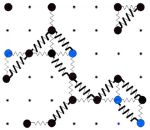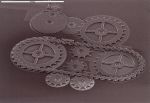News
EPJ B Colloquium - Thermodynamics and kinetics properties of condensed matter derived through the properties of an intrinsic defect
- Details
- Published on 24 January 2014

The theory of interstitialcy for simple condensed matters is a theory formulated by Andrew V. Granato enable the determination of the thermodynamic and kinetic properties of simple liquids and glasses. In a new Colloquium in EPJ B the author provides a simpler, more physical and compelling version of his interstitialcy theory. In addition, the results of computer simulations, together with direct and indirect experimental evidence, are updated and reviewed. In addition, the results of computer simulations, together with direct and indirect experimental evidence, are updated and reviewed. The connection between theory and experiment for some of the more notable properties of simple condensed matter is discussed. The direct visual observation of interstitial diffusion to the surface of irradiated platinum thin films near 20K by Morgenstern, Michely and Comsa provides compelling evidence for the interstitialcy theory presented herein.
EPJ B Highlight - Quasi-particle swap between graphene layers
- Details
- Published on 21 January 2014

Equations used to describe parallel worlds in particle physics can help study the behaviour of particles in parallel graphene layers
Belgian scientists have used a particle physics theory to describe the behaviour of particle-like entities, referred to as excitons, in two layers of graphene, a one-carbon-atom-thick honeycomb crystal. In a paper recently published in EPJ B, Michael Sarrazin from the University of Namur, and Fabrice Petit from the Belgian Ceramic Research Centre in Mons, studied the behaviour of excitons in a bilayer of graphene through an analogy with excitons evolving in two abstract parallel worlds, described with equations typically used in high-energy particle physics.
EPJ C goes Open Access funded by SCOAP3
- Details
- Published on 01 January 2014
As of January 2014, The European Physical Journal C – Particles and Fields will be published as full open access journal funded by SCOAP3. One of the leading journals in the field, EPJ C was selected to participate in this initiative - lead by CERN with the support of partners in 24 countries - which will make a vast fraction of scientific articles in the field of High-Energy Physics open access at no cost for any author. Moreover authors will retain copyright and creative commons licenses will enable wide re-use of the published material.
EPJ E Highlight - Elucidating biological cells’ transport mechanisms
- Details
- Published on 18 December 2013

A new study focuses on the motion of motor proteins in living cells, applying a physicist’s tool called non-equilibrium statistical mechanics
Motion fascinates physicists. It becomes even more intriguing when observed in vivo in biological cells. Using an ingenious setup, Japanese scientists have now calculated the force of molecular motors acting on inner components of biological cells, known as organelles. In this study, the focus is on mitochondria—akin to micrometric range cellular power plants—travelling along microtubules in a cell. Published in EPJ E by Kumiko Hayashi, from Tohoku University, Sendai, Japan, these findings could contribute to elucidating the transport mechanism in biological cells by multiple motors.
EPJ D Highlight - How hypergravity impacts electric arcs
- Details
- Published on 16 December 2013

A new study focused on electric discharge behaviour under intense gravitational forces shows that its dynamic changes as gravity increases
Arc discharges are common in everyday conditions like welding or in lightning storms. But in altered gravity, not as much is known about the behaviour of electric discharges. For the first time, Jiří Šperka from Masaryk University, Czech Republic, and his Dutch colleagues studied the behaviour of a special type of arc discharge, so-called glide arc, in varying hypergravity conditions, up to 18 G. In a paper just published in EPJ D, they demonstrate how the plasma channel of this glide arc discharge moves due to external forces of buoyancy in varying gravity conditions. These results could have implications for improved safety precautions in manned space flights, and in the design of ion thrusters used for spacecraft propulsion.
EPJE Colloquium - Electrification of wind-blown sand
- Details
- Published on 11 December 2013

A new Colloquium in EPJE by Xiao-Jing Zheng introduces and reviews the fundamental laws of the electrification of wind-blown sand and their influence, and highlights the challenges in this field.
The electrification of wind-blown sand is a typical complex system characterised by nonlinearity, randomness, multi-field coupling between thermal diffusion, E-fields and sand movements, as well as trans-scale processes with multi-phase media. Owing to the complex mechanism and the influence of the electrification of wind-blown sand [19], a number of issues remain poorly understood. These include: (1) why sand particles get charged during wind-blown sand movements; (2) how many electric charges a sand particle acquires; (3) why the electric polarity of sand particles is related to the particles’ size; (4) what the change law of wind-blown sand E-fields is, and (5) how to predict the intensity and influence of wind-blown sand E-fields.
EPJ D Highlight - Sharpening the focus in quantum photolithography
- Details
- Published on 11 December 2013

A new protocol, exploiting the quantum properties of materials, makes it possible to improve the accuracy of photolithography by addressing its physical limitations due to diffraction
Photolithography uses light beams to design thin geometric patterns on the substrates of semiconductors used in microelectronic devices. This is achieved using a chemical reaction on a light-sensitive chemical, called photoresist. The trouble is that the phenomenon of light diffraction does not permit highly accurate patterns. Often, the edges of stripes have low contrast, the distances between the stripes and the stripes’ width are limited by what is referred to as Rayleigh’s diffraction limit. Now, a scientist from Russia has developed a quantum lithography protocol designed to improve the resolution of this technology. The findings of George Miroshnichenko, a physicist at Saint-Petersburg National Research University of Information Technologies, Mechanics and Optics, in Russia, have just been published in EPJ D.
EPJ B Highlight - A step closer to composite-based electronics
- Details
- Published on 19 November 2013

A new study demonstrates that electrical resistivity obeys a staircase-like dependence on the conducting particle concentration in composite materials
Composite materials are of increasing interest to physicists. Typically, they are made of electrically conducting elements - such as spherical metallic or elongated carbon particles - embedded in an insulating glass or a polymer matrix. Their controllable electrical resistivity combined with their light and flexible properties, makes them suited for applications in flexible electronics. Now, a theoretical model, confirmed experimentally, elucidates how electrical resistivity varies with the concentration of the particles in these composite materials. These findings have been published in EPJ B, by Isaac Balberg and colleagues from the Hebrew University in Jerusalem, Israel.
EPJ D Colloquium - No qualms about quantum theory
- Details
- Published on 19 November 2013

The alleged shortcomings of quantum theory do not hold up to scrutiny, as the theory proves sound for the prediction of probability of events connected to the fate of sub-atomic scale particles
A colloquium paper published in EPJ D peers into the alleged issues associated with quantum theory. Berthold-Georg Englert from the National University of Singapore reviews a selection of the potential problems of the theory. In particular, he looks into cases when mathematical tools are confused with the actual observed sub-atomic scale phenomena they are describing. Such tools are essential to provide an interpretation of the observations, but cannot be confused with the actual object of studies.
EPJ B Highlight - Revisiting quantum effects in MEMS
- Details
- Published on 12 November 2013

New calculations shows that the influence of quantum effects on the operating conditions of nanodevices has, until now, been overestimated
Micro- and nano-electromechanical devices, referred to as MEMS and NEMS, are ubiquitous. These nanoscale machines with movable parts are used, for example, to trigger cars’ airbags following a shock. They can also be found in smartphones, allowing them to detect how to adequately display the screen for the viewer. The trouble is that, as their size decreases, forces typically experienced at the quantum level start to matter in these nanodevices. Mexican physicists have studied the mechanical and electrical stability of MEMS and NEMS, depending on the plate thickness and the nature of the material used. The results have now been published in EPJ B by Raul Esquivel-Sirvent and Rafael Perez-Pascual from the National Autonomous University of Mexico, in Mexico City.





